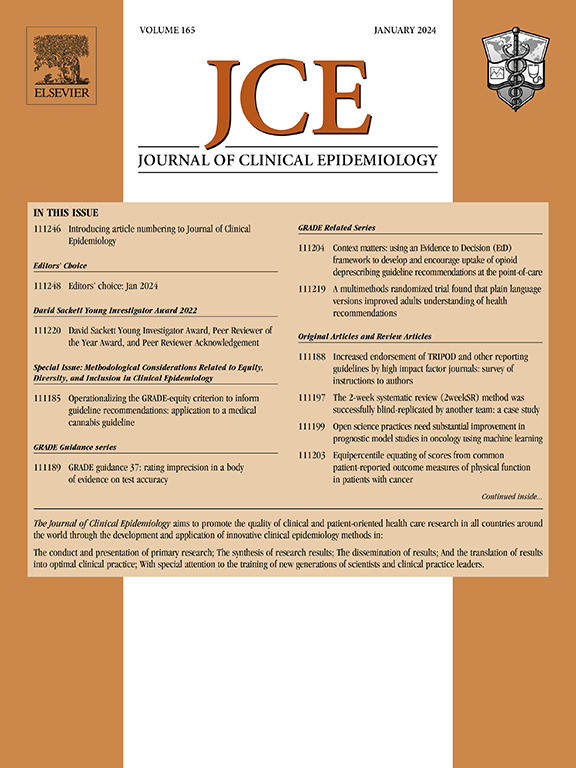对事件时间终点的传统和新型效果测量的评估:已发表的肿瘤学试验的荟萃流行病学研究。
IF 5.2
2区 医学
Q1 HEALTH CARE SCIENCES & SERVICES
引用次数: 0
摘要
在肿瘤试验中,时间到事件终点是评估治疗效果的关键。风险比虽然常用,但只反映相对效果,在不同的临床情况下可能不够。基于发病率和受限平均生存时间的传统测量方法,以及基于平均危害的新测量方法,提供了相对(基于比率)和绝对(基于差异)的视角。然而,这些措施尚未在现实世界的肿瘤试验中进行系统评估,限制了它们的实际应用。方法:本荟萃流行病学研究分析了5种高影响力期刊上发表的46项随机对照肿瘤试验的Kaplan-Meier曲线重构的个体患者数据,涉及35,994名患者和52条曲线。重建使用经过验证的算法从已发表的曲线中构建患者级数据。评价7项效果指标:风险比、发病率比及差异、受限平均生存时间比及差异、平均风险比及差异。使用可视化、中位数差异、Spearman等级相关和类内相关系数评估这些测量的两两一致性。结果:7项指标的临床方向一致,具有统计学意义。在4个基于比率(相对)的指标中,危险比、发病率比和平均危险比具有较高的一致性,中位差≤0.004,相关性>0.96,类内相关系数>0.87。限制平均生存时间比与其他相关指标的差异较大,约为1.25倍。危险的非比例性进一步使这一比率增加到1.38。在三个基于差异(绝对)的测量中,发病率差异和平均危险差异密切相关,而限制平均生存时间差异表现出很大的变异性,治疗效果幅度的中位数比超过300。结论:基于平均危险度的测量方法结合了相对和绝对角度,为危险度比提供了有希望的替代方法。基于限制平均生存时间的测量提供了临床相关的见解,但显示出实质性的差异;因此,它们应独立解释,而不应直接与其他措施进行比较。当没有其他度量标准时,基于发病率的度量可以作为实用的近似值。肿瘤学试验中多效应测量的常规报告可以增强临床解释,支持更细致、基于证据的决策。本文章由计算机程序翻译,如有差异,请以英文原文为准。
Assessment of traditional and novel effect measures for time-to-event endpoints: a meta-epidemiological study of published oncological trials
Objectives
Time-to-event endpoints are essential for evaluating treatment efficacy in oncology trials. The hazard ratio, although commonly used, captures only the relative effect and may not suffice in diverse clinical contexts. Traditional measures based on incidence rates and restricted mean survival time, along with novel measures based on average hazard (AH), offer both relative (ratio-based) and absolute (difference-based) perspectives. However, these measures have not been systematically evaluated in real-world oncology trials, limiting their practical application.
Methods
This meta-epidemiological study analyzed individual patient data reconstructed from Kaplan–Meier curves of 46 randomized controlled oncology trials published in five high-impact journals, involving 35,994 patients and 52 curves. The reconstruction used a validated algorithm to build patient-level data from published curves. Seven effect measures were evaluated: hazard ratio, incidence rate ratio and difference, restricted mean survival time ratio and difference, and AH ratio and difference. Pairwise concordance among these measures was assessed using visualizations, median differences, Spearman rank correlation, and intraclass correlation coefficients.
Results
There was a high agreement in clinical direction and statistical significance among the 7 measures. Among the four ratio-based (relative) measures, hazard ratio, incidence rate ratio, and ratio of AH demonstrated high agreement, with median differences ≤0.004, correlations >0.96, and intraclass correlation coefficients >0.87. The restricted mean survival time ratio showed substantial inconsistency, with other relative measures being approximately 1.25 times higher. The nonproportionality of hazards further increased this ratio to 1.38. Among the three difference-based (absolute) measures, incidence rate difference and AH difference were closely aligned, whereas the restricted mean survival time difference exhibited substantial variability, with median ratios of treatment effect magnitude exceeding 300.
Conclusion
AH–based measures provide promising alternatives to the hazard ratio by incorporating both relative and absolute perspectives. The restricted mean survival time based measures offer clinically relevant insights but exhibited substantial differences in magnitude; therefore, they should be interpreted independently and not directly compared with other measures. Incidence rate–based measures may serve as practical approximations when other metrics are unavailable. Routine reporting of multiple effect measures in oncology trials can enhance clinical interpretation and support more nuanced, evidence-based decision-making.
求助全文
通过发布文献求助,成功后即可免费获取论文全文。
去求助
来源期刊

Journal of Clinical Epidemiology
医学-公共卫生、环境卫生与职业卫生
CiteScore
12.00
自引率
6.90%
发文量
320
审稿时长
44 days
期刊介绍:
The Journal of Clinical Epidemiology strives to enhance the quality of clinical and patient-oriented healthcare research by advancing and applying innovative methods in conducting, presenting, synthesizing, disseminating, and translating research results into optimal clinical practice. Special emphasis is placed on training new generations of scientists and clinical practice leaders.
 求助内容:
求助内容: 应助结果提醒方式:
应助结果提醒方式:


